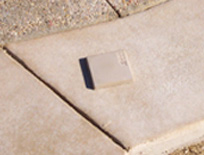Clients and Color Consistency

 For many of us in the custom watershape and landscape business these days, working with decorative concrete is an almost daily activity.
For many of us in the custom watershape and landscape business these days, working with decorative concrete is an almost daily activity.
In my business, for example, we custom-cast fountains, make poured-in-place coping, fabricate countertops, create pilaster caps — you name it. And we can make whatever the component happens to be in just about any color: It’s a flexibility we take advantage of to wonderful effect.
In addition to this remarkable aesthetic potential, the material is also affordable, which is certainly a factor in why decorative concrete has become so popular — not only with designers and contractors, but with consumers as well.
For all of its advantages, however, the material offers a color-related challenge that you have to consider ahead of time if you don’t want to run into trouble.
Scenario: The problem usually starts if the client has selected a very specific color based on a sample (or an image in a catalog) and expects an exact match in the field. For reasons to be discussed below, the color that develops in the field is seldom an exact match for any sample — a fact that can lead to unpleasantness ranging from grumpy clients who aren’t thrilled but accept the results to those who file lawsuits that lead to months or even years of miserable, costly, energy-sapping litigation.
One issue here is that all humans view things subjectively — and that, when they pay for them, they also tend to look at things critically. To be sure, some clients are more flexible and realistic when it comes to their expectations, but others are almost impossible to please.
A second issue is that the colors in decorative concrete can be extremely difficult to control in the field because there are so many variables that influence the result. First, you have to know how to use pigments correctly (to be discussed below), but you also have to be aware that air temperature on the day the concrete is mixed plays a part. So do the water/cement and gravel/sand ratios and the cement itself, which varies simply because it is a natural product.
The Fix: I always start with my clients’ expectations. They must understand that colored concrete is not the same as a can of paint, so any time you show them a sample or a color catalog, you must let them know that they are looking at approximate representations — especially when they’re seeing something in print, in which case you’ll almost never be able to achieve an exact match in the field.
This is why, whenever I can, I prefer using the tile-like samples provided by some color manufacturers. Again, there are so many variables at play that the result in the field will never be an exact match, but we’re generally able to come closer to a supplier’s sample pieces than we are to anything found in a printed brochure.
(A side note: This may cut against the grain with some professionals, but I’ve learned never to try to make my own samples to show our clients. Any sample I make will be prepared with powdered pigments, but in the field we typically work with material colored at the batch plant using liquid colorants — a completely different animal. When you factor in all the other variables, your own samples will almost certainly be different from the results found on site.)
The first part of this fix, always, is to set modest client expectations when it comes to exact color replication. If that frustrates them up front, it’s far better than it will be for them to be surprised and disappointed later, after the material goes in.
We find that when we explain all the variables, most clients are quick to understand and are more forgiving when or if they perceive slight color variations when the job is complete. By contrast, if your client resists and won’t accept variations, then it’s best to work with them in finding another material — stone or some other precast product — for which an actual sample can be provided.
The second part of the fix involves doing all you can to achieve color consistency, even though you know full well that there will be some variations. To that end, when we prepare batches of colored material on site, we have a set process we use that basically falls in line with the color manufacturer’s recommendations.
You must, for example, measure colorants by weight and not by volume, because most color powders are made from recycled materials and will vary in volumetric characteristics — even to the point that they will change in volume as they continue to be ground up in the cement mixer! So always use a scale to measure your colors, not some cup you picked up at a convenience store.
Lesson Learned: Clients are generally impressed when you confidently discuss the natural characteristics of concrete and the variables that affect its color and overall appearance. Being conversant in these issues is a great way to begin the process of establishing reasonable expectations.
Scott Cohen is president and supervising designer of The Green Scene, an outdoor design and construction firm based in Northridge, Calif. He provides consultation for clients nationwide and gives seminars on designing landscapes, swimming pools and outdoor kitchens. For more information, go to www.greenscenelandscape.com.









